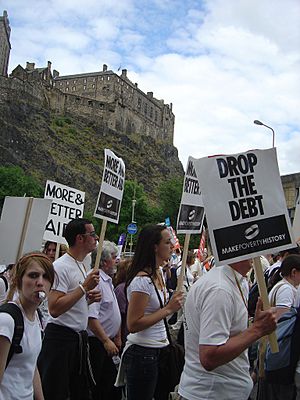Make Poverty History facts for kids

Make Poverty History was a big British and Irish campaign that aimed to stop poverty around the world. Poverty means not having enough money for basic things like food, water, and a safe home. This campaign wanted to help people in richer countries understand the problems faced by people living in poverty. It also pushed world leaders to take action.
The main symbol of the campaign was a white "awareness wristband." These bands were made of cotton or silicone. They had the words "MAKE POVERTY HISTORY" written on them. The word 'MAKE' and 'HISTORY' were in dark black, while 'POVERTY' was in a lighter black, making it stand out.
Contents
What Was the Make Poverty History Campaign?
The Make Poverty History campaign was a huge effort that started in 2005. Many different groups, charities, and millions of ordinary people joined together. Their main goal was to tell world leaders that it was time to end extreme poverty. They believed that with enough effort and fair rules, no one should have to live in such difficult conditions.
Why Did the Campaign Start?
The campaign started because many people felt that rich countries were not doing enough to help poorer nations. In 2005, the leaders of the world's eight biggest economies, known as the Group of Eight (G8), were meeting in Scotland. This meeting was a chance for campaigners to get their message directly to these powerful leaders. They wanted the G8 leaders to make big changes to help reduce poverty.
Key Goals of the Campaign
The Make Poverty History campaign had three main goals:
- More and Better Aid: They wanted richer countries to give more money and help to poorer countries. This aid would be used for things like schools, hospitals, and clean water.
- Fairer Trade Rules: They pushed for changes to global trade rules. Often, these rules made it hard for poor countries to sell their goods fairly to richer ones. The campaign wanted a system where everyone had a fair chance.
- Dropping Debt: Many poor countries owed huge amounts of money to rich countries. This "debt" made it very hard for them to spend money on their own people. The campaign asked for these debts to be cancelled, giving poor countries a fresh start.
How Did People Get Involved?
Millions of people supported Make Poverty History. They showed their support in many ways:
- Wearing White Bands: The white wristband became a very popular way to show you cared about the cause. Many celebrities and famous people wore them, which helped spread the message.
- Big Marches and Rallies: People took part in huge marches and demonstrations. One of the biggest was in Edinburgh, Scotland, just before the G8 summit. Hundreds of thousands of people walked together to show their support.
- Live 8 Concerts: A series of massive music concerts called Live 8 were held around the world. Famous musicians played for free to raise awareness. These concerts happened just before the G8 meeting and were watched by billions of people. They helped to make sure that poverty was the main topic of conversation.
- Signing Petitions: Millions of people signed petitions, asking their governments to take action. This showed leaders that many citizens cared deeply about ending poverty.
What Was the Impact of the Campaign?
The Make Poverty History campaign was very successful in getting people to talk about poverty. It put a lot of pressure on world leaders. After the G8 summit in 2005, some important promises were made:
- Richer countries promised to increase the amount of aid they gave.
- Some debts owed by the poorest countries were cancelled.
- There were discussions about making trade rules fairer.
While poverty still exists, the campaign helped to make a real difference. It showed that when millions of people come together, they can make their voices heard and encourage powerful leaders to act.
Images for kids
-
Police at the Edinburgh demonstration; Buccleuch Street



